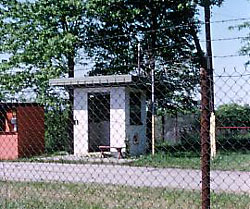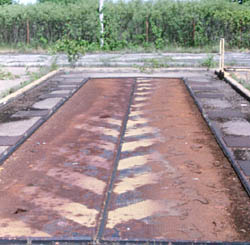
The Nike defense system was a significant aspect of both civilian life and military planning during the Cold War era in the United States. Nike missiles were radar guided, supersonic antiaircraft missiles. In keeping with the U.S. doctrine of "deterrence," planners hoped that systems like the Nike would make a direct attack on the continental United States so costly as to be futile. Nike Missile Site C-47 near Wheeler, Indiana, is an intact Nike base intended to protect a major potential target, Chicago. Although the Army's first surface-to-air missile defense program began in a 1944 memorandum, it was not until the Soviet Union developed new long range, high altitude bombers capable of reaching the United States, combined with the detonation of their atomic bomb in 1949, that the United States began to respond. President Truman reinforced the long held tenant that the Army was in charge of ground based antiaircraft artillery when he put them in charge of protecting the U.S. mainland from attack.
The Nike systems depended on three functional areas or components: radar systems to obtain, identify and track targets; a launch site with capability to handle multiple rockets; and an administrative section to coordinate and authorize launch. The mission of the Nike within the continental United States was to act as a "last ditch" line of air defense for selected areas. Nike missile sites like C-47 were constructed in defensive rings surrounding major urban and industrial areas. In all, the Army built more than 250 Nike-Hercules missile batteries across the United States during the late 1950s and early 1960s, protecting strategic military and civilian targets--the Chicago defensive area had about 20 bases ringing metropolitan Chicago. The SALT (Strategic Arms Limitation Talks) accords limited the deployment of the Nike-Hercules missiles. With the exception of batteries in Alaska and Florida that stayed active until the late 1970s, by 1975 all Nike-Hercules sites had been deactivated. C-47 closed in 1972.

The Nike Missile Site C-47 near Wheeler, Indiana, was constructed from 1954 to 1956 and consists of two separate parcels of land located nearly a mile apart. The first parcel of land, 14 acres, was the Launcher Area and is surrounded by two eight-foot-tall cyclone fences, original to the base. A guard shack remains at the main gate. The actual launchers, three independent concrete underground bunkers with blast doors, remain intact. This site has three modules, each with its own magazine, elevator and ventilation system. The Administrative Building, with its flat roof and concrete block construction, served as the day barracks where the launcher area crew would have their meals and relax during 24-hour shifts. The Fallout Shelter, to the east of the main gate, was constructed with solid poured concrete walls and roof system. The shelter has no windows and once had blast doors to protect the occupants from nuclear fallout. The largest building on the launcher site is the Vehicle Maintenance Building.
The second parcel of land was for the Control Area and contains 13 buildings, five radar towers, a wastewater treatment in-ground enclosure, basketball court and a cyclone fence. All the buildings at the Control Area are single-story, slab-floored, concrete walled buildings with flat roofs. The Administration Building housed the day room, supply rooms and a barbershop.
Visit the National Park Service Travel American Aviation to learn more about Aviation related Historic Sites.
Last updated: November 26, 2017
